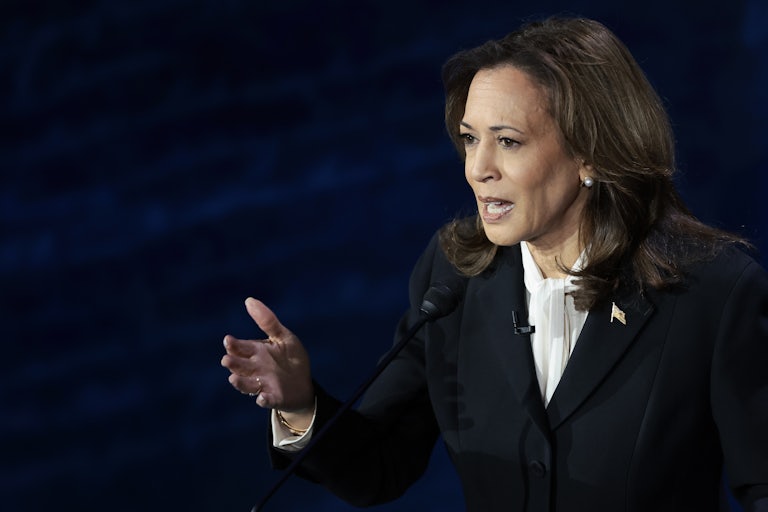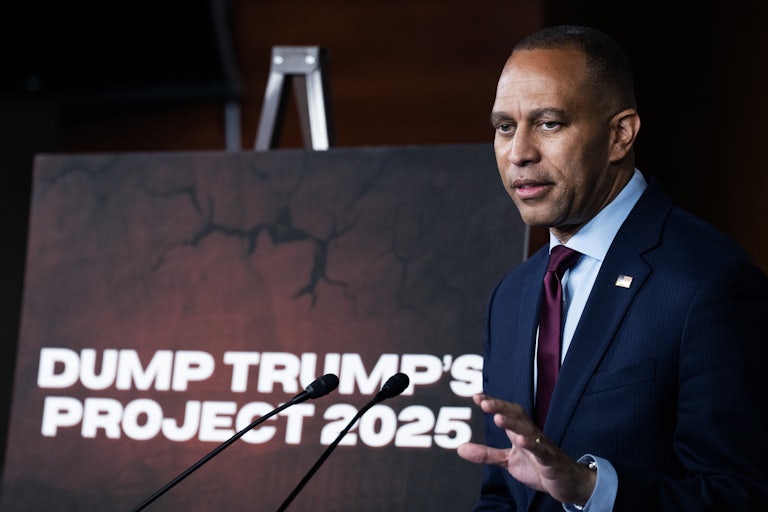Three Critical Arguments Harris Needs to Make in These Final Days
Here are some ideas to help Democrats close the deal with the widest possible swath of persuadable voters.

Our exhausting permanent presidential campaigns eventually lead us to this point: less than one month to go, the home stretch, the closing argument. It’s taken a lot for Democrats to reach this point with a real shot at actually winning the presidency, but it will still be a white-knuckle affair. For Kamala Harris, the polling is good, and rather steady, but not great. Donald Trump, despite having spent the past few weeks defaming innocent Haitian Americans and spreading untold lies about hurricane recovery efforts, is still very close to winning himself.
Is Harris doing enough to beat him at the finish line? I’m not so sure. As The New Republic’s Alex Shephard wrote this week, Harris is making something of a too-close-for-comfort retread of her first, failed presidential run. Harris has arrived at this point too guarded and overcautious, he argues, with too many edges sanded off and what seems like a different policy walk-back every day. “With Election Day fast approaching,” Alex writes, “there’s a growing sense that she could—and should—be doing more.”
But what “more” should she be doing? My two cents: Harris needs to drill down on specific matters that help define her candidacy, contrast it with the corrupt impunity that a second Trump term will bring, and cast the widest possible net to woo any or all voters who might join her coalition. Specifically, here are three matters critical enough to be part of any closing argument that Harris and her Democratic allies make in these final days:
1. I know that I’m a broken record on this, but Democrats really need to raise the salience of the Supreme Court. Everyone committed to a Harris victory should make it clear that there are two Supreme Court vacancies at stake: Clarence Thomas and Samuel Alito may not be signaling a desire to retire from the bench, but a Trump win gives them the option to escape, knowing that like-minded replacements will be on their way. And while it might be difficult to find juridical minds more troglodytic than the two most venerable members of the conservative majority, you can definitely find younger bodies into which their ideas might be stuffed.
This is honestly the alpha and omega of anything Democrats might otherwise argue. Right now, with the current majority having gutted Chevron deference, anything that might be considered a “Democratic policy” is subject to the review of a hostile court that’s making up the rules as they go along. It’s possible that Democrats don’t really understand how bad a position they’re in now that Loper Bright is the law of the land. They should listen to the judicial experts in their corner—or get some new ones. Regardless, “Two Supreme Court vacancies are at stake in this election” needs to become a mantra.
2. As I predicted some months ago, 2024 has become a year defined by Republicans largely lying about their unpopular positions on abortion rights. They will, of course, seek to ban nationally as soon as the opportunity presents itself (before moving on to other retrograde policies from Project 2025’s pages). Trump and his running mate, JD Vance, have in recent weeks gone all in on the centerpiece of their deception, constantly reiterating that Trump will veto any abortion ban that crosses his desk. While it’s ordinarily sufficient to point out that Trump cannot be trusted and that Harris and her fellow Democrats have more convincingly committed themselves to safeguarding reproductive rights, Harris and her allies must do a better job explaining how Republicans actually plan to bring about a national abortion ban if Trump is elected.
As The New Republic’s Melissa Gira Grant points out, such a ban is not going to arrive in the form of a bill landing on Trump’s desk; Congress need not be involved at all.
What Trump might do—what his allies want him to do—is enact a ban by enforcing the 1873 Comstock Act, which can’t be vetoed since it’s already on the books. Trump’s misdirection distracts from his consistent anti-abortion record while in office, what the Republican Party platform states, and the very public plans of his former staffers detailed in Project 2025, which Trump also pretends he has nothing to do with. That is part of the Trump-Vance campaign’s plan on abortion: to do whatever they can not to talk about that plan, or at least to confuse the public about what that plan is.
This is a strong issue for Harris, which is all the more reason not to fight this battle on Trump’s terms but to actually level with people about what he intends to do. In their two debate performances, the Harris-Walz ticket failed to make mention of Comstock, despite the fact that Vance actually asked the DOJ to enforce it in a January 2023 letter. This needs to change: Democrats have the truth on their side, and it’s stupid to not use it against an inveterate liar, dissembling on an issue of paramount importance.
3. If abortion is one of the Democratic Party’s best issues, then immigration has to be one of their worst. As I noted a few weeks ago, any hope that we might return to sane comprehensive immigration reform policies has been scotched after the Biden administration entered into a race to the bottom with the GOP’s nativist cranks. The biggest overhang of Trump’s first term is that he managed to set the terms on immigration and yank Democrats to the right. He’s also managed to drag public opinion in his direction. A September 18 Ipsos poll found that there is majority support for some form of mass deportation—a policy Trump plans to deliver.
Democrats haven’t exactly met Trump’s demonization of Haitian Americans with a full-throated defense of these citizens, and it’s not clear that Harris has the stomach for that sort of entanglement. There’s too little daylight between Trump and Harris on immigration, but his plan to exile tens of millions of Americans is the centerpiece of his campaign, so Democrats should attack it with gusto. Fortunately they have another angle to wage war: Correctly depict Trump’s plan as a neutron bomb on the American economy.
As The New Republic contributor Nicholas Slayton reported this week, a recent report from the American Immigration Council found that Trump’s plan would unleash a parade of economic horrors, including estimated GDP losses between 4.2 and 6.8 percent, a $46.8 billion hole in federal coffers, corresponding state and local revenue losses in excess of $29 billion, and “significant labor shocks across multiple key industries, with especially acute impacts on construction, agriculture, and the hospitality sector.” These aftershocks would all create an environment in which “hundreds of thousands of U.S.-born workers could lose their jobs.”
Plus, the total cost to taxpayers just to implement this plan to destroy the U.S. economy would be in the vicinity of $315 billion (a figure the AIC says is “highly conservative”), which would give Democrats the chance to ask Trump the question so often chucked in their direction: “But how will you pay for it?”
It’s not ideal that Harris has been a risk-averse politician—and I personally wish she was more like Biden on economic matters. But these faults are things we can all fight about later down the line. Harris needs to end this election making the arguments necessary to put the Trump epoch behind us. These three areas give Harris broadly appealing arguments to make and clear contrasts to raise, forcing Trump to defend the MAGA extremism that now dictates much of our everyday lives.
Best of all, these aren’t the kind of risky stances from which Harris has heretofore shied away. This is normie bait: good for the broad Democratic coalition, salient to swayable Republican voters, and relevant to habitual nonvoters that both campaigns hope to get off the fence. Winning in November may boil down to a few big contrasts that will define the future—and whether or not Democrats can speak with one voice about why their version of the future is preferable.
This article first appeared in Power Mad, a weekly TNR newsletter authored by deputy editor Jason Linkins. Sign up here.









